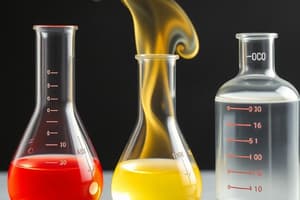Podcast
Questions and Answers
What is the approximate air pressure in kilopascals (kPa)?
What is the approximate air pressure in kilopascals (kPa)?
- 101300 kPa
- 1000 kPa
- 1 kPa
- 101.3 kPa (correct)
What is the Kelvin temperature equivalent to 25 °C?
What is the Kelvin temperature equivalent to 25 °C?
- 303 K
- 273 K
- 298 K (correct)
- 248 K
Which pressure unit is often used for tire pressure?
Which pressure unit is often used for tire pressure?
- mmHg
- atm
- torr
- PSI (correct)
What is the pressure in kPa equivalent to 6.4 atm?
What is the pressure in kPa equivalent to 6.4 atm?
What is the standard ambient temperature and pressure (SATP)?
What is the standard ambient temperature and pressure (SATP)?
What is the relationship between volume and temperature of a gas according to Charles' Law?
What is the relationship between volume and temperature of a gas according to Charles' Law?
What is the formula for Charles' Law?
What is the formula for Charles' Law?
What is Boyle's Law?
What is Boyle's Law?
According to the Combined Gas Law, what happens to the volume of a gas when pressure and temperature both increase?
According to the Combined Gas Law, what happens to the volume of a gas when pressure and temperature both increase?
What is the relationship between the number of molecules of a gas and the pressure it exerts?
What is the relationship between the number of molecules of a gas and the pressure it exerts?
What does the Kinetic Molecular Theory state about gas molecules?
What does the Kinetic Molecular Theory state about gas molecules?
Which of the following is a factor that influences the pressure exerted by a gas?
Which of the following is a factor that influences the pressure exerted by a gas?
What is the relationship between intermolecular forces and the distance between gas molecules?
What is the relationship between intermolecular forces and the distance between gas molecules?
Which of the following conditions would most likely cause a real gas to deviate significantly from ideal gas behavior?
Which of the following conditions would most likely cause a real gas to deviate significantly from ideal gas behavior?
What is the primary assumption made about gas particles in the Ideal Gas Law?
What is the primary assumption made about gas particles in the Ideal Gas Law?
In the equation pv = nRT, what does the variable 'R' represent?
In the equation pv = nRT, what does the variable 'R' represent?
Which gas law describes the relationship between the volume of a gas and its temperature, assuming constant pressure and moles?
Which gas law describes the relationship between the volume of a gas and its temperature, assuming constant pressure and moles?
According to the Ideal Gas Law, if the pressure of a gas sample is doubled while the temperature remains constant, what happens to the volume?
According to the Ideal Gas Law, if the pressure of a gas sample is doubled while the temperature remains constant, what happens to the volume?
Which gas law is most closely related to the Ideal Gas Law?
Which gas law is most closely related to the Ideal Gas Law?
In a laboratory experiment, how can the molar mass of a gas be determined using the Ideal Gas Law?
In a laboratory experiment, how can the molar mass of a gas be determined using the Ideal Gas Law?
In the context of gas laws, what does the term 'K' usually represent?
In the context of gas laws, what does the term 'K' usually represent?
What is the volume occupied by 1 mole of any gas at STP?
What is the volume occupied by 1 mole of any gas at STP?
How many moles of oxygen are there in a volume of 5.6 L at STP?
How many moles of oxygen are there in a volume of 5.6 L at STP?
What is the volume occupied by 3.50 g of helium at SATP?
What is the volume occupied by 3.50 g of helium at SATP?
According to Avogadro’s Theory, how do the number of molecules in 2.0 L of H2 gas compare to the number of molecules in 2.0 L of NH3 gas, measured at the same temperature and pressure?
According to Avogadro’s Theory, how do the number of molecules in 2.0 L of H2 gas compare to the number of molecules in 2.0 L of NH3 gas, measured at the same temperature and pressure?
Which of the following relationships is correctly represented by Boyle’s Law?
Which of the following relationships is correctly represented by Boyle’s Law?
Which of the following represents the relationship between the volume and temperature of a gas, according to Charles’ Law?
Which of the following represents the relationship between the volume and temperature of a gas, according to Charles’ Law?
Which of the following is a factor that affects the volume of a gas according to the Kinetic Molecular Theory (KMT)?
Which of the following is a factor that affects the volume of a gas according to the Kinetic Molecular Theory (KMT)?
If you have 1 mole of gas at SATP, what is its volume?
If you have 1 mole of gas at SATP, what is its volume?
According to Boyle's Law, what happens to the volume of a gas when the pressure is increased?
According to Boyle's Law, what happens to the volume of a gas when the pressure is increased?
Which of the following variables is held constant in Boyle's Law?
Which of the following variables is held constant in Boyle's Law?
A gas sample has a volume of 2.5 L at a pressure of 100 kPa. If the pressure is increased to 200 kPa, what is the new volume of the gas?
A gas sample has a volume of 2.5 L at a pressure of 100 kPa. If the pressure is increased to 200 kPa, what is the new volume of the gas?
Which of the following best describes the relationship between pressure and volume in Boyle's Law?
Which of the following best describes the relationship between pressure and volume in Boyle's Law?
In the experiment described in the content, what is the independent variable?
In the experiment described in the content, what is the independent variable?
In the experiment described, why is the atmospheric pressure added to the pressure readings obtained by the gauge?
In the experiment described, why is the atmospheric pressure added to the pressure readings obtained by the gauge?
What is the purpose of the experiment involving the syringe and bottle?
What is the purpose of the experiment involving the syringe and bottle?
If a gas sample is compressed to half its original volume, what will happen to the pressure?
If a gas sample is compressed to half its original volume, what will happen to the pressure?
What is the first step in performing gas stoichiometry?
What is the first step in performing gas stoichiometry?
What is the primary reason for using helium in balloons instead of argon?
What is the primary reason for using helium in balloons instead of argon?
How is the molar mass of butane calculated using the ideal gas law?
How is the molar mass of butane calculated using the ideal gas law?
What should be included in the procedure section of the butane lab report?
What should be included in the procedure section of the butane lab report?
What does the percent difference measure in the context of the butane lab?
What does the percent difference measure in the context of the butane lab?
What is a key factor affecting the performance of a CO2 fire extinguisher?
What is a key factor affecting the performance of a CO2 fire extinguisher?
Why does a hot air balloon rise?
Why does a hot air balloon rise?
Which step is NOT part of the gas stoichiometry process?
Which step is NOT part of the gas stoichiometry process?
Flashcards
What is pressure?
What is pressure?
The force applied perpendicularly to a surface per unit area. Think of the difference in pressure when standing on your toes compared to standing with your entire foot flat on the ground.
What is 1 kPa equal to?
What is 1 kPa equal to?
The SI unit of pressure, equivalent to 1000 Newtons per square meter. It is commonly used for measuring gas pressures.
What is SATP?
What is SATP?
The standard ambient temperature and pressure, where the temperature is 25 degrees Celsius and the pressure is 100 kPa.
What is STP?
What is STP?
Signup and view all the flashcards
What is absolute zero?
What is absolute zero?
Signup and view all the flashcards
Boyle's Law
Boyle's Law
Signup and view all the flashcards
Absolute Zero
Absolute Zero
Signup and view all the flashcards
Charles' Law
Charles' Law
Signup and view all the flashcards
Combined Gas Law
Combined Gas Law
Signup and view all the flashcards
Kinetic Molecular Theory
Kinetic Molecular Theory
Signup and view all the flashcards
Pressure of a Gas
Pressure of a Gas
Signup and view all the flashcards
Volume and Temperature Relationship
Volume and Temperature Relationship
Signup and view all the flashcards
Intermolecular Forces in Gases
Intermolecular Forces in Gases
Signup and view all the flashcards
Gases fill their container
Gases fill their container
Signup and view all the flashcards
Gases are compressible
Gases are compressible
Signup and view all the flashcards
Temperature affects gases
Temperature affects gases
Signup and view all the flashcards
Boyle's Law Formula
Boyle's Law Formula
Signup and view all the flashcards
Temperature in Kelvin (K)
Temperature in Kelvin (K)
Signup and view all the flashcards
Boyle's Law Graph
Boyle's Law Graph
Signup and view all the flashcards
Avogadro's Theory
Avogadro's Theory
Signup and view all the flashcards
Molar Volume (STP)
Molar Volume (STP)
Signup and view all the flashcards
Molar Volume (SATP)
Molar Volume (SATP)
Signup and view all the flashcards
Gay-Lussac's Law
Gay-Lussac's Law
Signup and view all the flashcards
What is an ideal gas?
What is an ideal gas?
Signup and view all the flashcards
How do real gases differ from ideal gases?
How do real gases differ from ideal gases?
Signup and view all the flashcards
What is Boyle's Law?
What is Boyle's Law?
Signup and view all the flashcards
What is Charles's Law?
What is Charles's Law?
Signup and view all the flashcards
What is the Combined Gas Law?
What is the Combined Gas Law?
Signup and view all the flashcards
What is the Ideal Gas Law?
What is the Ideal Gas Law?
Signup and view all the flashcards
What is the Law of Combining Volumes?
What is the Law of Combining Volumes?
Signup and view all the flashcards
What is the Universal Gas Constant (R)?
What is the Universal Gas Constant (R)?
Signup and view all the flashcards
What is molar mass?
What is molar mass?
Signup and view all the flashcards
How do you calculate percent difference?
How do you calculate percent difference?
Signup and view all the flashcards
What is density?
What is density?
Signup and view all the flashcards
What is gas stoichiometry?
What is gas stoichiometry?
Signup and view all the flashcards
Why are chemical equations balanced?
Why are chemical equations balanced?
Signup and view all the flashcards
What is a mole ratio?
What is a mole ratio?
Signup and view all the flashcards
Study Notes
Gases - Day 1
- A gas demo was presented, illustrating gas behavior.
- The images show a gas tank involved in an accident.
Common Gas Terms
- Pressure is defined as force per unit area.
- Standard units for pressure include kilopascals (kPa), which is equal to 1000 N/m².
- Atmospheric pressure is approximately 101.3 kPa.
- Other pressure units include atmospheres (atm), millimeters of mercury (mmHg), and torr.
- The torr unit is named after Evangelista Torricelli, an Italian physicist and mathematician who developed the barometer.
- PSI (pounds per square inch) is a common unit for tire pressure.
Pressure Unit Conversions
- Using a conversion factor, students can switch between different units of pressure,
- Providing an example of converting between Pascals (Pa) and kilopascals (kPa), the conversion factor is 1 kPa = 1000 Pa.
Complete Table
- This table shows examples of pressure conversions.
- The table is filled with different units of pressure, and their corresponding conversions to kilopascals (kPa).
Temperature Scales
- The Celsius scale is commonly used; it's based on water's properties.
- The Kelvin scale is an absolute scale of temperature; this is also referred as Absolute zero, which is 0 K or -273°C.
- Converting from Celsius to Kelvin is done by adding 273 to the Celsius temperature.
Standard Gas Conditions
- SATP represents Standard Ambient Temperature and Pressure and is 25°C and 100 kPa.
- STP stands for Standard Temperature and Pressure and is defined as 0°C and 1 atmosphere (101.325 kPa).
- These are useful reference points for gas calculations.
Properties of Gases
- Gases completely fill their containers.
- Gases can be compressed significantly, making their volumes dependent on pressure.
- Temperature affects gas pressure and volume.
- Gases adhere to the gas laws.
Evidence Table (Boyle's Law)
- Shows tabular data related to Pressure and Volume.
- Data used for plotting graphs and finding the relationship.
Evidence Table (Charles' Law)
- Presents tabular data for Temperature and Volume.
- used for plotting graphs and finding the relationship.
Looking at Graphs
- Exploring relationships between pressure and volume (Boyle's Law), and temperature and volume (Charles' Law).
Boyle's Law
- When pressure increases, volume decreases proportionally.
- Pressure and volume are inversely related, while temperature and moles remain constant.
The Combined Gas Law
- P1V1/T1= P2V2/T2. (The amount of gas remains the same).
Kinetic Molecular Theory
- Gases continually move at random speeds and continually collide with each other and the walls of their container.
- Collisions are perfectly elastic.
- Pressure is calculated by considering the frequency and force of collisions.
Gas Molecules
- Gas molecules are far apart, and intermolecular forces are weak.
- Gases are easily compressible.
The Average Kinetic Energy of Gas Molecules
- The average kinetic energy is directly proportional to temperature (in Kelvin)
Boyle's Law and KMT
- The pressure of a gas increases if the volume of the container decreases, due to the increased frequency of collisions with the walls of the container.
The Law of Combining Volumes
- A method used to calculate the volumes of gaseous reactants and products if pressure and temperature remain constant.
Gas Stoichiometry
- A process used to quantify volume and mass if the pressure and temperature are fixed.
Molar Volume
- A numerical conversion factor that represents the volume occupied by 1 mole of gas under STP or SATP conditions.
The Ideal Gas Law
- A law used to relate pressure, volume, temperature, and the number of moles of a gas with a constant (R).
- PV = nRT (p= pressure, v = volume, n = number of moles, r constant, t = temperature)
Density
- This section introduces the concept of density in relation to gases.
- Discussion includes whether argon balloons would work as well as helium balloons.
- Examining the reasons why balloons are filled with Helium instead of Argon, given Density differences between the gases
Hot Air Balloons
- The concept of density plays a key role in the rise of hot air balloons, which is related to pressure, and temperature
Studying That Suits You
Use AI to generate personalized quizzes and flashcards to suit your learning preferences.




